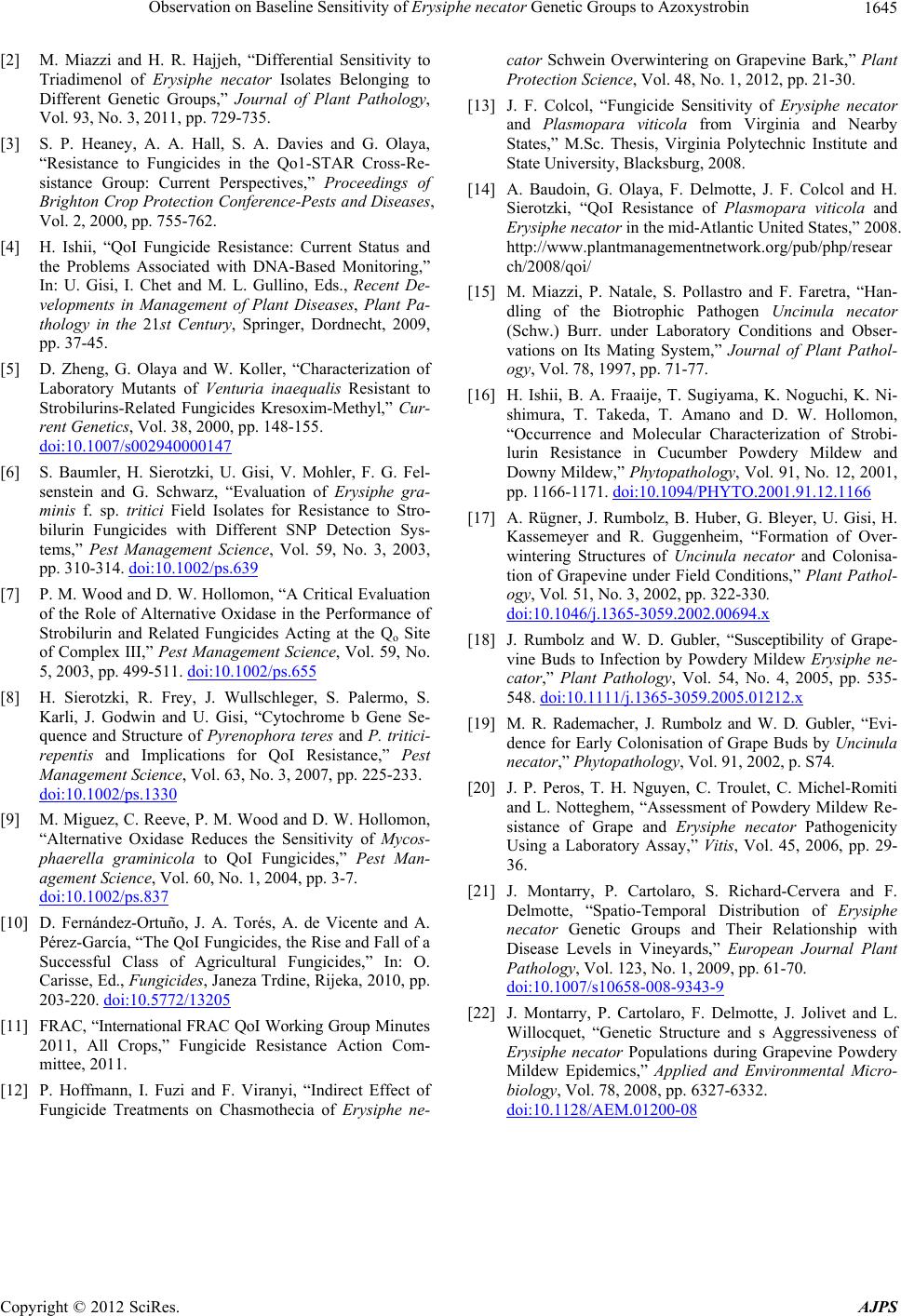
Observation on Baseline Sensitivity of Erysiphe necator Genetic Groups to Azoxystrobin 1645
[2] M. Miazzi and H. R. Hajjeh, “Differential Sensitivity to
Triadimenol of Erysiphe necator Isolates Belonging to
Different Genetic Groups,” Journal of Plant Pathology,
Vol. 93, No. 3, 2011, pp. 729-735.
[3] S. P. Heaney, A. A. Hall, S. A. Davies and G. Olaya,
“Resistance to Fungicides in the Qo1-STAR Cross-Re-
sistance Group: Current Perspectives,” Proceedings of
Brighton Crop Protection Conference-Pests and Diseases,
Vol. 2, 2000, pp. 755-762.
[4] H. Ishii, “QoI Fungicide Resistance: Current Status and
the Problems Associated with DNA-Based Monitoring,”
In: U. Gisi, I. Chet and M. L. Gullino, Eds., Recent De-
velopments in Management of Plant Diseases, Plant Pa-
thology in the 21st Century, Springer, Dordnecht, 2009,
pp. 37-45.
[5] D. Zheng, G. Olaya and W. Koller, “Characterization of
Laboratory Mutants of Venturia inaequalis Resistant to
Strobilurins-Related Fungicides Kresoxim-Methyl,” Cur-
rent Genetics, Vol. 38, 2000, pp. 148-155.
doi:10.1007/s002940000147
[6] S. Baumler, H. Sierotzki, U. Gisi, V. Mohler, F. G. Fel-
senstein and G. Schwarz, “Evaluation of Erysiphe gra-
minis f. sp. tritici Field Isolates for Resistance to Stro-
bilurin Fungicides with Different SNP Detection Sys-
tems,” Pest Management Science, Vol. 59, No. 3, 2003,
pp. 310-314. doi:10.1002/ps.639
[7] P. M. Wood and D. W. Hollomon, “A Critical Evaluation
of the Role of Alternative Oxidase in the Performance of
Strobilurin and Related Fungicides Acting at the Qo Site
of Complex III,” Pest Management Science, Vol. 59, No.
5, 2003, pp. 499-511. doi:10.1002/ps.655
[8] H. Sierotzki, R. Frey, J. Wullschleger, S. Palermo, S.
Karli, J. Godwin and U. Gisi, “Cytochrome b Gene Se-
quence and Structure of Pyrenophora teres and P. tritici-
repentis and Implications for QoI Resistance,” Pest
Management Science, Vol. 63, No. 3, 2007, pp. 225-233.
doi:10.1002/ps.1330
[9] M. Miguez, C. Reeve, P. M. Wood and D. W. Hollomon,
“Alternative Oxidase Reduces the Sensitivity of Mycos-
phaerella graminicola to QoI Fungicides,” Pest Man-
agement Science, Vol. 60, No. 1, 2004, pp. 3-7.
doi:10.1002/ps.837
[10] D. Fernández-Ortuño, J. A. Torés, A. de Vicente and A.
Pérez-García, “The QoI Fungicides, the Rise and Fall of a
Successful Class of Agricultural Fungicides,” In: O.
Carisse, Ed., Fungicides, Janeza Trdine, Rijeka, 2010, pp.
203-220. doi:10.5772/13205
[11] FRAC, “International FRAC QoI Working Group Minutes
2011, All Crops,” Fungicide Resistance Action Com-
mittee, 2011.
[12] P. Hoffmann, I. Fuzi and F. Viranyi, “Indirect Effect of
Fungicide Treatments on Chasmothecia of Erysiphe ne-
cator Schwein Overwintering on Grapevine Bark,” Plant
Protection Science, Vol. 48, No. 1, 2012, pp. 21-30.
[13] J. F. Colcol, “Fungicide Sensitivity of Erysiphe necator
and Plasmopara viticola from Virginia and Nearby
States,” M.Sc. Thesis, Virginia Polytechnic Institute and
State University, Blacksburg, 2008.
[14] A. Baudoin, G. Olaya, F. Delmotte, J. F. Colcol and H.
Sierotzki, “QoI Resistance of Plasmopara viticola and
Erysiphe necator in the mid-Atlantic United States,” 2008.
http://www.plantmanagementnetwork.org/pub/php/resear
ch/2008/qoi/
[15] M. Miazzi, P. Natale, S. Pollastro and F. Faretra, “Han-
dling of the Biotrophic Pathogen Uncinula necator
(Schw.) Burr. under Laboratory Conditions and Obser-
vations on Its Mating System,” Journal of Plant Pathol-
ogy, Vol. 78, 1997, pp. 71-77.
[16] H. Ishii, B. A. Fraaije, T. Sugiyama, K. Noguchi, K. Ni-
shimura, T. Takeda, T. Amano and D. W. Hollomon,
“Occurrence and Molecular Characterization of Strobi-
lurin Resistance in Cucumber Powdery Mildew and
Downy Mildew,” Phytopathology, Vol. 91, No. 12, 2001,
pp. 1166-1171. doi:10.1094/PHYTO.2001.91.12.1166
[17] A. Rügner, J. Rumbolz, B. Huber, G. Bleyer, U. Gisi, H.
Kassemey er and R. Guggenheim, “Formation of Over-
wintering Structures of Uncinula necator and Colonisa-
tion of Grapevine under Field Conditions,” Plant Pathol-
ogy, Vol. 51, No. 3, 2002, pp. 322-330.
doi:10.1046/j.1365-3059.2002.00694.x
[18] J. Rumbolz and W. D. Gubler, “Susceptibility of Grape-
vine Buds to Infection by Powdery Mildew Erysiphe ne-
cator,” Plant Pathology, Vol. 54, No. 4, 2005, pp. 535-
548. doi:10.1111/j.1365-3059.2005.01212.x
[19] M. R. Rademacher, J. Rumbolz and W. D. Gubler, “Evi-
dence for Early Colonisation of Grape Buds by Uncinula
necator,” Phytopathology, Vol. 91, 2002, p. S74.
[20] J. P. Peros, T. H. Nguyen, C. Troulet, C. Michel-Romiti
and L. Notteghem, “Assessment of Powdery Mildew Re-
sistance of Grape and Erysiphe necator Pathogenicity
Using a Laboratory Assay,” Vitis, Vol. 45, 2006, pp. 29-
36.
[21] J. Montarry, P. Cartolaro, S. Richard-Cervera and F.
Delmotte, “Spatio-Temporal Distribution of Erysiphe
necator Genetic Groups and Their Relationship with
Disease Levels in Vineyards,” European Journal Plant
Pathology, Vol. 123, No. 1, 2009, pp. 61-70.
doi:10.1007/s10658-008-9343-9
[22] J. Montarry, P. Cartolaro, F. Delmotte, J. Jolivet and L.
Willocquet, “Genetic Structure and s Aggressiveness of
Erysiphe necator Populations during Grapevine Powdery
Mildew Epidemics,” Applied and Environmental Micro-
biology, Vol. 78, 2008, pp. 6327-6332.
doi:10.1128/AEM.01200-08
Copyright © 2012 SciRes. AJPS